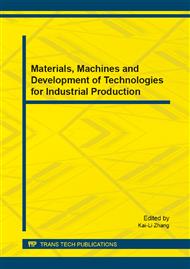p.154
p.159
p.164
p.170
p.175
p.180
p.184
p.189
p.193
Preparation of 3DON Li4Ti5O12 and Behavior of Li+ Ion Exchange
Abstract:
The three-dimensionally ordered nanopores 3DON lithium ionic sieve precursors Li4Ti5O12 were synthesized by homemade polymethyl methacrylate (PMMA) colloidal crystal templates filled with lithium acetate, tetrabutyl titanate, oxalic acid and critric acid mixed solution after melt crystallization. The corresponding LiTi-H as a new lithium ion-sieve was obtained after the dilute hydrochloric acid treatment. The morphology and structure of the material were analyzed with SEM and X-ray diffraction (XRD), and saturated exchange capacity, adsorptive selectivity and reusability characterized the ion exchange properties. It turns out that PMMA colloidal crystal templates and 3DON precursors Li4Ti5O12 arranged orderly and macro pore diameter was approximately 80nm. What’s more, Li4Ti5O12 were spinel phase and lithium ionic sieve LiTi-H had a high selectivity for Li+, saturated exchange capacity for Li, 56.81mg (Li+).g-1 and good acid stability.
Info:
Periodical:
Pages:
175-179
Citation:
Online since:
August 2014
Authors:
Keywords:
Price:
Сopyright:
© 2014 Trans Tech Publications Ltd. All Rights Reserved
Share:
Citation:


